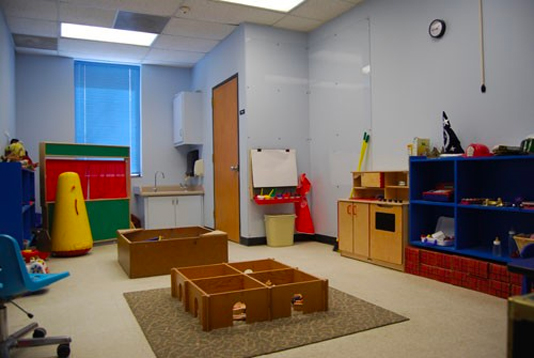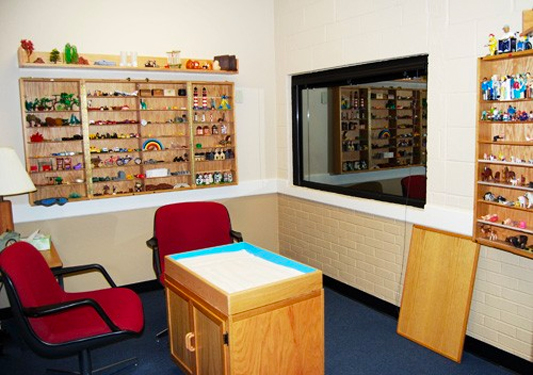Playroom Video Tour
Playroom Photos

Play room

Activity room

Sandtray room
Playroom Toys & Materials
"Toys and materials should be selected, not collected."
(Landreth, 2024, p. 176)
The toys and materials are the medium in which children in play therapy express themselves. These therapeutically selected items serve an important role in play therapy and should be chosen based on sound rationale.
Below are general guidelines to follow when selecting playroom items.
- Toys should provide variety in choice of expression
- Toys should be durable
- Toys should not be complex
- Toys should allow reality testing of limits
- Toys should allow development of positive self-image as well as self-control
Toys and materials can have an effect on the type and amount of expression and interaction with the therapist. Selection of the toys should be done with attention to the impact they will have on the growth of the child. Dr. Garry Landreth in his textbook, Play Therapy: The Art of the Relationship, touches on three broad toy categories.
Real-Life Toys
This category consists of toys that are directly representative of real-world items including doll families, dollhouse, puppets, cars, boats, airplanes, cash register, and play money among other things.
Aggressive-Release Toys
This toy grouping allows for the release of emotions that are typically not allowed to be expressed in other settings and includes Bobo or the bop bag, toy soldiers, rubber knives, and toy guns (that purposely do not look realistic). Less obvious, but still important are egg cartoons and Popsicle sticks that can be physically broken down and destroyed.
Creative Expression Toys
This category contains toys that allow for creativity. Paints, butcher paper and an easel, crayons, sand, water, and instruments. Depending on the setting of the playroom, some of these items may need to be replaced with an alternative item.
Material adapted from Landreth, G. L. (2024). Play therapy: The art of the relationship. (4th ed.). Routledge.
Recommended Toys
and Materials for
the Playroom
Learn MoreView our list of Toy Vendors
Learn MorePlayroom Toys & Materials
Create A Therapeutic Environment: A Well-Planned and Organized Space is Very Important Especially for Distressed and Traumatized Children
- Orderly and Predictable
- Allow for Messiness & Ease of Clean Up
Criteria for Selecting Toys and Materials
Toys should:
- Allow for exploration of real-life experiences, including cultural values, traditions, and roles
- Facilitate contact with the child by gaining the child's interest and attention
- Permit reality testing/limit setting
- Provide the opportunity for development of self-control
- Facilitate exploration of the self and others
- Allow children to express their needs symbolically (without any need for verbalization)
- Provide for expression of a wide range of feelings
- Provide opportunities for insight/self-understanding
- Allow for creative expression
- Toys should also be durable, simple, and easy to operate, allow for success & are fun
Reminder: Toys should be selected, not collected
Categories of Toys
- Real-life and Nurturing
Doll family, doll house, baby bottle, variety of puppets, animal families, cars, money, cash, register, kitchen food, medical kit, phone, etc. - Acting-out, Aggressive, Scary Toys (or not?)
Bop bag, toy soldiers, guns (colored plastic-not real looking!), scary/aggressive puppets and animals (alligator, shark, etc), rubber knife, foam sword, handcuffs, etc. - Creative expression and emotional release:
Sand, water, paints, craft materials, clay, musical instruments, magic wand, dress-up clothes, etc.
Toys and Materials For Play Therapy
Fully Equipped Playroom
- Doll furniture (sturdy wood)
- Gumby (bendable nondescript figure)
- Doll bed, clothes, etc.
- *Bendable doll family
- *Dolls
- Pacifier
- Nursing bottle (plastic)
- Chalkboard, chalk
- Refrigerator (wood)
- Dishes (plastic or tin)
- Pitcher
- *Plastic food
- Egg cartons
- Broom, dustpan
- *Crayons, pencils, paper
- Toy watch
- Paints, easel, newsprint, brushes
- Lone Ranger type mask
- Tongue depressors, popsicle sticks
- *Truck, car, airplane, tractor, boat
- Pounding bench and hammer
- *Cymbals
- Toy soldiers and army equipment
- Sandbox, large spoon, funnel, sieve, pail
- Rubber snake, alligator
- *Multicolored chalk, eraser
- Stove (wood)
- *Pans, silverware
- Dishpan
- *Empty fruit and vegetable cans, etc. Band-aids
- Sponge, towel
- Soap, brush, comb
- Transparent tape
- Building blocks (diff. shapes and sizes)
- Play-Doh or clay
- Pipe cleaners
- ATV (multi-wheel vehicle for riding on)
- School bus (Fisher Price type)
- *Xylophone
- *Drum
- *Fireman's hat, other hats
- Zoo animals, farm animals
- Bop bag (Bobo)
- Handcuffs
- Toy noise making gun
- *Telephone (two)
- *Construction paper (several colors)
- Rags or old towels
- Tinker toys
- Tissue
- Rubber Knife
- Dart gun
- Balls (large and small)
- Medical kit
- Blunt scissors
- Play money and cash register
- *Hand puppets (doctor, nurse, etc.)
- Rope
- *Purse and jewelry
